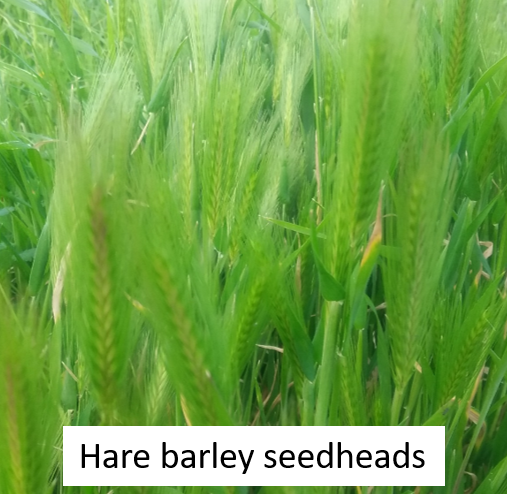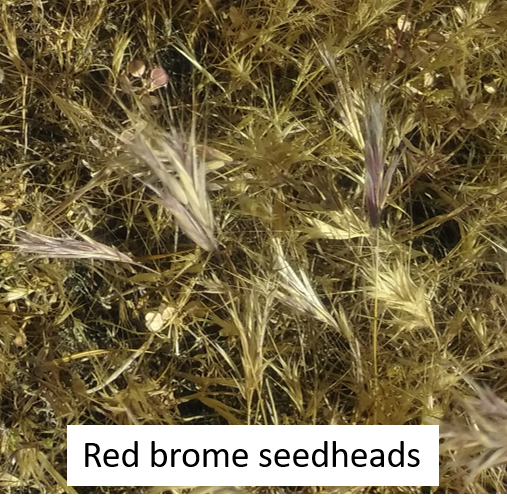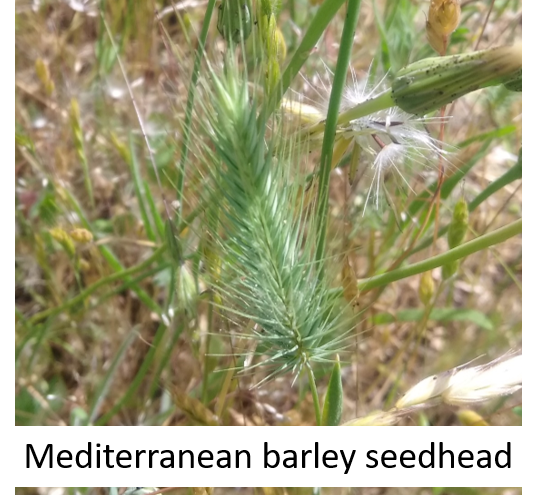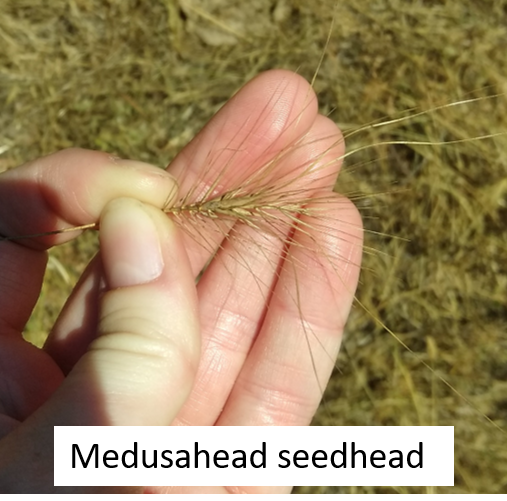From roadsides in the city of Fresno to the oak woodlands in nearby Sequoia National Park, annual barleys and bromes are going to seed. In addition to a variety of other grasses, I often hear landowners, weed managers, pet owners, and veterinary advice blogs call these species "foxtails". This common name is applied to so many species that if someone tells me they have a foxtail issue, I have to ask to see it so that I know what species we need to manage.

Image: Hare barley in the spring, with fluffy spike seedheads.
The term "foxtail" also means different things in different contexts*. In the veterinary context, the term "foxtail" typically describes a grass seed that has barbed awns that catch on animal hair and can cause serious injury, often affecting dogs. In the landscape context, the term "foxtail" typically refers to one of many grass species that produce a characteristic spike of awned seeds, and/or produces the kinds of seeds which hitch rides and cause injury in animals.

Image: Red brome after senescence in the spring, showing spiky seeds. These seeds, when found in animal fur, are often identified as "foxtails".
Here I compiled a brief table of grasses commonly called "foxtails" (or their seeds are; in Fresno and Madera Counties):
|
Official common name |
Scientific name |
Notes |
|
Hare or Mouse barley |
Hordeum murinum |
Very common; robust seedhead, often taller than Mediterranean, and has clasping auricles |
|
Mediterranean barley |
Hordeum marinum |
Less common than Hare barley; slightly bluer color, smaller, and has no auricles |
|
Foxtail barley |
Hordeum jubatum |
Not a common culprit; native perennial bunchgrass, slender seedheads |
|
Red or Foxtail brome |
Bromus madritensis |
Very common; seedheads generally upright, turn purplish red when maturing |
|
Cheatgrass or Downy brome |
Bromus tectorum |
Less common in my counties; seedheads droop, but seeds similar to red brome |
|
Ripgut brome |
Bromus diandrus |
Common species, but not often labeled a "foxtail" – awns are long and distinctive |
|
Medusahead |
Taeniatherum caput-medusae |
A more recent invader in my counties, seeds appear similar to annual barleys |
NOTE: This list is not comprehensive. There are many grass species in California that have seeds which can hitch a ride on livestock, clothing, and equipment. In addition, there are grass species (Setaria spp.) whose common name is actually "foxtail", but they are uncommon in my counties and they are not typically associated with animal injuries.

Image: Mediterranean barley in the spring, showing a similar spike seedhead but is slightly bluer than hare barley.
As you can see, many different species are commonly labeled "foxtails". Most of them have the same impact to landscapes and animals: the grasses outcompete desired species, and they typically stick their awns in anything they touch. Livestock can carry the seeds in their hair, hide, or hooves, and avoid eating these grasses once the seedhead has developed, due to the barbed awns. People can find the seeds stuck in shoes, socks, and any other clothing, equipment, or pets that have somewhere for an awn to attach.
While it's fine to consider all of these species "foxtails" - the impact to you, your animals, or the landscape is similar, though not identical, across these grasses - it's important to know what species you are dealing with before attempting any control methods.

Image: Medusahead in the summer, showing long, twisted awns on a seedhead that is otherwise similar to the annual barleys.
Each species poses its own challenges and has different vulnerabilities. For instance, foxtail barley is the only perennial in my list; it will respond differently to management than the annual species. The bromes and annual barleys are winter annuals, sprouting in the fall and going to seed in spring. Medusahead can also sprout in the fall, but goes to seed later than the other annuals.
For assistance identifying which kind of “foxtail” might be troubling you, I recommend checking out the Weed Research and Information Center (Weed RIC) resources on weeds by crop/topic or contacting your local farm advisor who can help with plant ID and management options.
*In a physical activity context, a foxtail is a toy where a ball has a fabric tail attached to it for throwing. Fortunately, this kind of foxtail doesn't seem to be an invasive species unless you have a neighbor with poor aim.